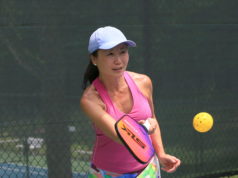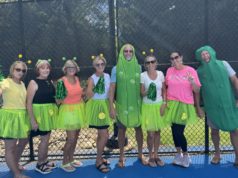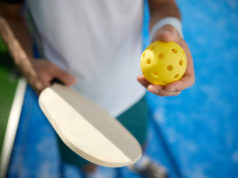By Lamar Scott, Men’s League Vice President
Good doubles players know they should be moving constantly on the court. Most players know what to do when the ball is hit directly to them, but what do players do when the ball is not hit directly to them? With the fall season swiftly approaching, it’s important for doubles players to know how to move, where to move, and why to move when the ball is not coming to them.
There are three basic positions for doubles play: both players at the net, both players at the baseline, and one player at net and one player at the baseline. Both players at the net is generally considered the best system.
In addition to being comfortable moving forward, and thinking offensively, it’s just as important to move defensively and force the opponent into a less desirable, lower-percentage shot. Proper defensive positioning will help players anticipate where the ball is coming from and where the ball is going; that leads back to strong offense and more points won.
While maintaining the principles of the ballside movement, the doubles team should move together laterally. The ballside and non-ballside position will vary depending on whether the ball bounces wide to the alleys or inside toward the T. If the ball bounces wide, both players shift in that direction.
Better Doubles Guidelines
A player should move to specific areas during a point
Good doubles players are always in a ready position to receive the ball. If in a good defensive position, chances are better for returning a good offensive shot. Positioning forces a lower-percentage shot by opening up only a small area of the court.
Good doubles teams are in constant motion
While it is ideal for teams to move forward and closer to the net, moving forward and backward, as well as side to side, also are important to successful doubles.
Be square to the opponent who will be hitting the next ball
Squareness: the feet, hips, and shoulders must be facing your opponent. This opponent is usually the ballside player (closer to the net). Too often, players stand facing straight ahead, rather than with their bodies squared up opposite the player hitting the next ball. Think about your positioning when you receive the serve.
All players should be aware of the angle of the shot
The hitter will follow the direct path of the ball. Other players should shift in the same direction of the ball.
The three players who are not hitting the ball on the court should be involved in ‘off-ball’ movement
“Off-ball” is the movement of the players who are not going to receive the ball, moving either toward the net or off the net.
Doubles Court Positioning
For a crosscourt return:
Server (S)
• Movement Pattern: Advance to the net toward the service line and T area.
Receiver (R)
• Positioning: Should be squared off to the server (belly button, feet, and shoulders facing server).
• Role: Hit the return over the net and crosscourt, away from net player.
• Movement Pattern: After returning the ball crosscourt, move toward the service line following the ball.
Receiver’s Partner (RP)
• Positioning: On service line near the ‘T,’ squared off to the server’s partner (SP)
• Role: Watch the SP. If the ball goes to the SP, play goalie and defend the ‘T’ by blocking the ball back in play.
• Movement Pattern: If the return is crosscourt and not volleyed by the net player (SP at net does not poach/volley the return), move toward the net and assume ballside position.
Server’s Partner (SP)
• Positioning: Approximately 1/3 the distance between the net and service line. The SP is considered ballside because the serve will bounce across the net on the same half of the court as the SP.
• Role: Volley, smash, or poach the return, if possible.
• Movement Pattern: If the service return passes the SP, off-ball movement begins. The SP squares off to the RP (the new ballside player), takes slide steps parallel to the path of the ball and toward the service line/T area, assuming the non-ballside position. The eyes of the SP should be focused on the RP, rather than tracking the ball back to the server.
Many claim they play tennis for exercise and yet, when they play doubles, the only time they move is when they are receiving the ball. Some say, “Well, I want to move, but I don’t know where to go.” The system of continuous movement gives the player a road map of where and when to move. Players will be active not only when they are hitting the ball, but also moving when they are not hitting the ball. This will dramatically improve your doubles game for the fall season.




